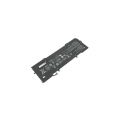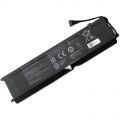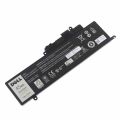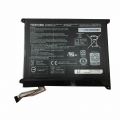How to Find Hp Laptop Batteries Model Number?

If you're planning on replacing the battery yourself, you can check the battery's model number. Of course, the specifics of accessing your laptop's internal components will differ based on the model, but here's a general description of how it works.
Power down your computer and unplug both the charging cord and any connected devices if you have any.
1. Turn the laptop over.
If necessary, carefully remove the rubber feet to reveal screws.
If your laptop has strip-style rubber feet, remove them slowly and carefully; they can tear easily.
2. Remove all of the screws attaching the bottom plate to the laptop.
This hardware usually requires a 00 Phillips screwdriver.
3. Keep track of which screws you remove from which holes, as they may be different lengths. You'll need to make sure you return them to the same spots when you reassemble your laptop.
If necessary, use a thin, plastic tool to carefully pry the bottom plate off.
4. Locate the battery, which will be on the same side of the computer as the charging port.
The battery should have the model and power information printed directly on it; note this info and find a battery online or in-store, either of the same type or with identical specifications.
Most batteries will have a set of printed information on them, including the battery type, its model number, a part number, its voltage, and a charging current. Presently, the lithium-ion battery -- usually listed as Li-ion -- is the most common type, though older laptops may have a nickel-cadmium or nickel-metal hydride battery.
The shape of the laptop battery and the location of the connection must be as same as your original battery. Your battery part number or laptop model is listed on the compatibility list before making a purchase.
Meet the specifications: You can’t squeeze a 3-inch battery made for a Dell laptop into the 2-inch slot on a Toshiba. It’s physically impossible, and even if you could squeeze it in, the electrical connectors probably wouldn’t line up. Match the voltage, If your original battery was rated at 14.8 volts, that’s the ticket for the replacement model. Don’t go over or under the specified power,10.8v and 11.1 are compatible, and 14.4v and 14.8v are compatible. The 10.8v(=11.1v) and 14.4v(=14.8v) are the different voltages. They are not compatible. Consider going high capacity, within the manufacturer’s specifications, you may be able to replace your original battery with one with a higher watt-hour or amp-hour rating. This allows you to work longer.
Use Software
Not all batteries are easy to remove or even clearly marked, so some third-party utilities can be used to determine what type of battery should be put into a laptop. BatteryCare and Notebook Hardware Control (links in Resources) are free pieces of software that provide a lot of detailed information on a computer's battery, covering everything needed when searching for a replacement. BatteryMon (link in Resources) gives even more information on your specific battery, such as its chemistry, and is free for the first 30 days.
BatteryMon is also a tool that can be used to monitor the battery usage of laptops and UPS, and thereinto all parameters of the battery are expressed by intuitive charts in real-time.
How to Find the Model of My Laptop Computer?
1Close your laptop and flip it over, you can see the Model Name and Part Number on the bottom of your laptop. As shown in the picture on the left.
2Holding down the [Fn] key and hit the [Esc] key on your laptop keyboard. Then you can see related information on it. As shown below.







